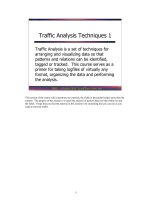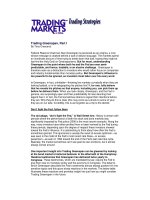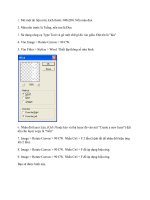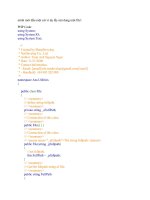Tài liệu Writing template part 1 pdf
Bạn đang xem bản rút gọn của tài liệu. Xem và tải ngay bản đầy đủ của tài liệu tại đây (1.52 MB, 10 trang )
Copyright
®
by the University of Michigan 2007
All rights reserved
ISBN-10: 0-472-03193-7
ISBN-13: 978-0-472-03193-1
Published in the United States of America
The University of Michigan Press
Manufactured in the United States of America
® Printed on acid-free paper
2010 2009 2008 2007 4 3 2 1
No part of this publication may be reproduced, stored in a reuieval system, or transmitted in
any form or by any means, electronic, mechanical, or otherwise, without the written permission
of the publisher.
The Writing
Template Book
The
MICHIGAN Guide to
Writing Well
and
Success
on
High-Stakes Tests
Kevin B. King
Northern Essex Community College
New Hampshire Community Technical College
Foreword by Ann M Johns
San Diego State University
Ann Arbor
THE
UNIVERSITY OF MICHIGAN PRESS
FOREWORD
During my more than 30 years of teaching writing to international,
bilingual, Generation 1.5, and other students, I have been introduced
to,
and attempted, all of the major pedagogical approaches. In the
1950s and early '60s, when the teaching of writing became an issue sep-
arate from the teaching of language, we were introduced to the current-
traditional methods, product-based approaches in which focus on
correct form dominated our work (see Johns 1997). When writing mat-
tered and wasn't just a reflection of speech (see the audiolingual
method),
we were interested, first of all, in perfect representations of
words and sentences. Weiderman (2000) refers to this period in lan-
guage teaching history as "scientific": teachers "proceeded in a lockstep
fashion, teaching bits of language from the grammatically simple to the
grammatically more complex" (5). Our colleagues in first language
composition and the work in contrastive rhetoric also introduced us to
simple discourse forms. Comparison-contrast, cause-effect, and narra-
tive were three forms that we taught, in a lockstep manner, as structures
for essays. There seemed to be only one ESL (and novice student) com-
position book, American English Rhetoric by Robert Bander, published by
Holt, Rinehart, and Winston, that we were given to use in our composi-
tion classes. A typical chapter title was "The Expository Composition:
Developed by Comparison and Contrast."
Influenced in the 1960s by world events and remarkable changes in
the United States, we began to question the approaches that concen-
trated solely on form and correctness, considering them to be too
constraining for the students we were attempting to liberate. Thus, there
occurred in composition instruction (and elsewhere) a major paradigm
shift: from focus on perfect sentences and perfectly structured texts to the
students, writers drafting and redrafting their assignments to solve
rhetorical problems through texts. The learner-centered "process" move-
ment, which continues to be basic to many composition programs,
concentrated its efforts upon developing the learners' search for mean-
ing and their writing processes. Rather than devoting time to perfection
in student writing and stamping out errors, the teachers encouraged
vi Foreword
meaning-making, drafting, revising, and redrafting, all taking place in a
collaborative environment where students peer reviewed each other's
work. Students were encouraged throughout the process to reflect, thus
developing a metacognitive awareness of their individual ways of
approaching, and solving, their rhetorical problems. For some students
and many teachers the process movement has, in fact, been liberating.
As we now know so well, perfection and form are not all there is to
successful writing.
However, there's another side of the process story that needs to be
considered as we teach novice and second language students, many of
whom do not yet control the registers or syntax of academic or profes-
sional Englishes. Jim Martin (1985), an Australian theorist, argues that
the process movement has benefited only certain groups of students:
those who are sufficiently familiar with the text products ("the genres")
required in professional or academic context. Martin maintains that
process approaches "promote a situation in which only the brightest,
middle-class, monolingual students will benefit" (61) since they are the
ones who have already begun to be initiated by their families or their
elite schools into the academic and professional discourse communities
they plan to enter. As Anyon (1980) and others have noted, most
schools are already structured by social class, preparing selected
students for certain types of professional lives. Support of these class dis-
parities has no place in our composition programs.
So what do we do? We attempt, in some way, to close the gaps
among rich, middle class, and poor as well as between those who speak
and write English in various registers with ease and those who don't. In
the theory and practice that is typical of post-process methodologies, a
variety of pedagogies designed to achieve these ends have been devel-
oped.
Some of those efforts follow the work of the New Rhetoricians in
North America (see, e.g., Coe 2002), individuals who believe that to
understand writing, a person must first understand the context and
community in which the writing takes place. Others, such as the
Australians and English for Specific Purposes practitioners, argue that
we must teach the functional relationships between what a text should
do linguistically and its purposes for the communities in which it will
be read or published. In the Australian context (see Feez 1998), curric-
ula have been designed to demonstrate these functional relationships at
the text ("genre") and sentence levels. Both text structure and syntax are
shown as contributing to success of a text in a specific context.
The Writing Template Book addresses the needs of students who are
preparing for high-stakes assessments in contexts where they have
little time to consider their writing processes. It provides for students
and teachers three types of templates: the thesis, the introduction/
roadmap, and the summary, representing three essential elements in
essay structures that are frequently required in high-stakes examina-
tions, nationally (the SAT*), internationally (the TOEFL® iBT), and
more locally, in many city, state, and provincial examinations. Ini-
tially, this volume will be useful for novice and ESL/EFL students as
they attempt to write under these timed, and stressful, assessment sit-
uations. However, the volume can also provide the "training wheels"
for writing sentences and paragraphs in a variety of genres for a variety
of contexts. Throughout, the author makes the connections between
essential discourse functions of essays and other genres (e.g., intro-
duction, argument) and the structures of sentences and paragraphs
that work. He provides a number of syntactic possibilities (see, e.g.,
Conclusion Templates) that teachers (and students) can vary accord-
ing to prompts or tasks. He demonstrates how these templates can
assist students to produce a text that is comprehensible even if errors
are made (Roadmap Template Examples with Student Errors, pages
49-51).
Fully as important are the vocabulary alternatives, some of
which are quite sophisticated. In the Do you Think Introduction
Template (page 45), for example, the author lists seven adjectives
(fascinating, difficult, tough, thought-provoking, interesting, multi-dimensional,
and provocative), each of which has a somewhat different semantic
value. This type of exercise enables teachers and students to examine
the differences among the choices, thereby indicating author stance on
the issue (see Hyland 2005).
As Kevin B. King notes in his introduction, "one size does not fit
all."
This book cannot possibly illustrate the large variety of sentences
that fulfill the functions in written texts. However, what it will do for
students—and do it well—is get them started, giving them opportuni-
ties to explore the syntax, vocabulary, and functions of sentences and
paragraphs in the assessments that determine their futures.
Using this volume, teachers can
• introduce and encourage student practice of one or more possi-
bilities in an essential functional category (e.g., Proposition
Template, Hedged Disagreement), varying the language and
syntax as the students become more proficient
• select one of the sentences produced by students in their prac-
tice and work through a paragraph that follows from that
sentence
viii
Foreword
• assist students in modifying the sentences produced to respond
to new, but related, prompts
• encourage students to find examples of sentences and paragraphs
that serve the same function in authentic texts from the worlds in
which they live
• help students to continue to practice sentence variation,
particularly in response to a variety of tasks and prompts—so that
eventually they will not need the training wheels provided in this
volume
As I attend conferences such as that on College Composition and
Communication (CCCC) and talk to my colleagues who teach native
speakers, I notice that textbooks with templates that serve rhetorical
functions have entered their worlds, as well. The Writing Template Book is
an excellent contribution to our pedagogical worlds, particularly for our
novice and ESL students who are preparing for high-stakes examinations.
Ann M. Johns, San Diego State University
September 2006
References
Anyon, Jean. "Social Class and the Hidden Curriculum of Work." Journal
of Education 162, no. 1 (Fall 1980).
Coe,
Richard M. "The New Rhetoric of Genre: Writing Political Briefs."
In Genre in the Classroom: Multiple Perspectives, ed. Ann M. Johns.
Mahwah, NJ: Lawrence Erlbaum, 2002.
Feez,
Susan. Text-Based Syllabus Design. Macquarie University: National
Centre for English Language Teaching, 1998.
Hyland, Ken. "Stance and Engagement: A Model of Interaction in
Academic Discourse." Discourse Studies 7 (2005): 173-92.
Johns, Ann M. Text, Role, and Context: Developing Academic Literacies.
New York: Cambridge University Press, 1997.
Martin, Jim. Factual Writing: Exploring and Challenging Social Reality.
New York: Oxford University Press, 1985.
Weiderman, A. "L2 Writing: Subpresses, a Model for Formulating
Empirical Findings." Learning and Instruction 10 (2000): 73-99.
CONTENTS
INTRODUCTION FOR STUDENTS
1
What Are Writing Templates? 1
Why Do You Need Templates? 1
What about Standardized Tests like the SAT® and the TOEFL®? 2
How Do the Template Options Work? 3
INTRODUCTION FOR TEACHERS
4
General Remarks 4
Art, Craft, or Science? 6
Templates and Standardized Writing Tests
(SAT®,
TOEFL®) 9
Concluding Remarks 9
THESIS
SENTENCE TEMPLATES
11
How the Thesis Sentence Templates Work 11
I. Comparison/Contrast Thesis Sentences
12
Comparison/Contrast Template
1 12
Comparison/Contrast Template
2 13
Comparison/Contrast Template
3 14
II.
Proposition Thesis Sentences
14
Proposition Template
1
(Agreement)
15
Proposition Template
2
(Disagreement)
17
Proposition Template
3
(Disagreement)
19
Proposition Template
4
(Disagreement)
20
Proposition Template
5
(Disagreement)
21
Proposition Template
6
(Hedged Disagreement)
22
Proposition Template 7 23
Proposition Template 8 24
III.
Thesis Sentences from Prize-Winning Essays 25
Thesis Sentence Template 1 25
Thesis Sentence Template 2 27
Thesis Sentence Template 3 (Definition) 28
Thesis Sentence Template 4 29
Thesis Sentence Template 5 30
Thesis Sentence Template 6 (Transformation) 31
INTRODUCTION TEMPLATES 33
I. General Introduction Templates 33
General Introduction Template 1 33
Simplified Introduction Template 36
General Introduction Template 2 38
II.
Introduction with Questions Templates 40
What Is Introduction Templates 40
Why, Who, and What Do/Does Template 42
Do You Think Introduction Template 45
III.
Roadmap Templates 47
Roadmap Template for Question Introduction 47
Roadmap Template Examples with Student Errors 49
Question Series Introduction/Roadmap 53
Argument Roadmap Template 1 56
Argument Roadmap Template 2 58
Roadmap Template without First Person 60
Contrasting Views Roadmap Template 62
Advanced Roadmap Template 65
Roadmap for Long Paper 67
CONCLUSION TEMPLATES 69
Very Short Conclusion Templates 71
Rhetorical Question Template 1 73
Rhetorical Question Template 2 74
Rhetorical Question Template 2a 76
Conclusion Template 1 78
Argument Conclusion Template 81
Conclusion Template 2 (Effect) 83
Strong Claim Conclusion Template 85
Conclusion Template 3 87
Advanced Conclusion Template 89
BODY
OF PAPER TEMPLATES 91
Body Template, Last Paragraph 91
Body Template, Opposing Argument 94
SUMMARY TEMPLATE
96









